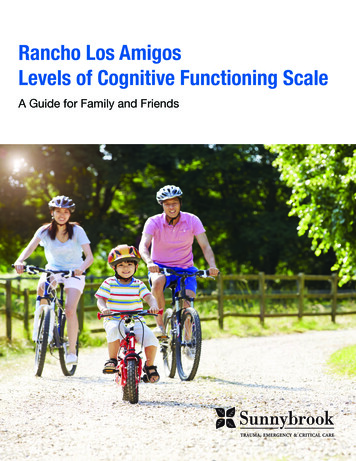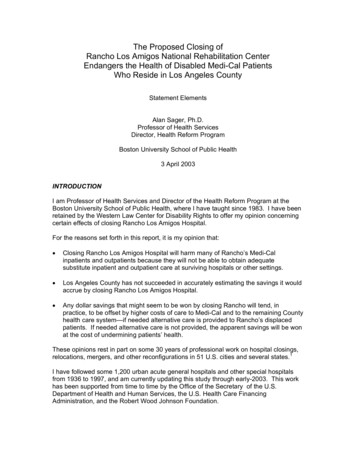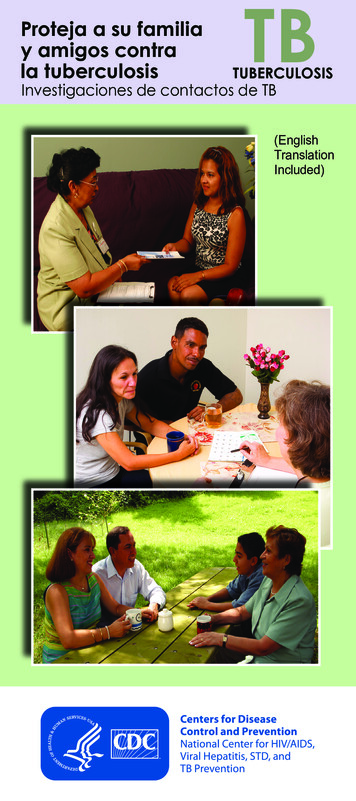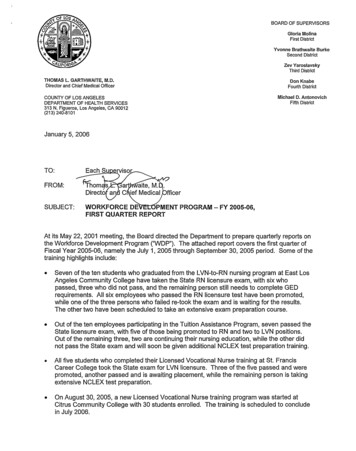
Transcription
Rancho Los AmigosLevels of Cognitive Functioning ScaleA Guide for Family and Friends1
INTRODUCTIONThis guide will give you and your family helpful information about brain injury recovery. It explainshow people with a brain injury recover from a cognitive and behavioural point of view.COGNITION is the word we use to describe the brain’s thinking skills, such as memory, attention,problem solving, judgment, and someone’s awareness of what has happened to them.BEHAVIOUR is the word that describes how the patient with a brain injury is acting in dailysituations. Some behaviours may be safe and appropriate, and other behaviours may present adanger to the patient/others.At Sunnybrook, we use a scale to describe these patterns of recovery, called the Rancho LosAmigos Levels of Cognitive Functioning Scale.A FEW FACTS. The Rancho scale was developed by avery well-known brain injury rehabilitationhospital in California. It will give you examples of what you cando to help your family member or friendwhen you visit. It is used to rate how people with braininjury are recovering. There are eight levels of recovery. This handout will go through each level andtell you what you might expect to see asyour loved one recovers.We also use this scale to help decidewhen the patient is ready for rehabilitation.Your health care team will give you moreinformation about rehabilitation when thetime is right.2
Every patient’s brain works differently. Even when the exact same injury happens to two different brains,people may show different symptoms, behaviors, and speeds of recovery. The Rancho Scale is used as aguide only, not everyone fits perfectly into one particular level. Some patients may demonstrate aspectsand behaviours of more than one level at a time.Often patients will show signs of recovery first to loved ones and family. This is normal. The goal of recoveryis for the patient with the brain injury to have the same responses at different times of the day, consistentwith all the people involved in their care. You, as a loved one, are an important part of the care team. Pleasehelp us by telling us anything you notice about your loved one’s responses to the environment.There is space at the end of this handout for you to write down your observations and any questions youmay want to ask your healthcare team.INFORMATION ABOUT TRAUMATIC BRAIN INJURY (TBI): A TBI is when the brain is hurt by an externalforce, such as a fall or a knock to the head.The injury may be mild, moderate or severe. The amount of harm to the brain can be small,such as a headache. If the injury is severe, thepatient may not be able to move, eat or takecare of themselves without a lot of help. Understanding the patterns and levels ofrecovery can help you to understand what toexpect while your loved one is in the hospital. It is important to remember that everyone doesnot recover in the same way. Medications to calm the head-injured patientare used as little as possible. This is becausemedication can slow the thinking process andin some cases can make confusion worse.LEVELS OF RECOVERYAs the patient with a head injury starts to “wake up” they usually go through different levels of recoveryon the Rancho Scale.How long can it take for the patient to “wake up” and recover?This will depend on:1.2.3.4.5.How serious the patient’s head was injuredHow long it took to get medical helpHow serious the patient’s other injuries and complications areThe age and general health of the patient before the injuryThe involvement of family/friendsThese levels describe a general pattern of recovery. The levels of recovery are:LEVEL 1LEVEL 2LEVEL 3LEVEL 4LEVEL 5CONFUSED – INAPPROPRIATE –NON-AGITATEDLEVEL 6CONFUSED – APPROPRIATENO RESPONSEGENERALIZED RESPONSELOCALIZED RESPONSELEVEL 7LEVEL 8CONFUSED – AGITATED3AUTOMATIC – APPROPRIATEPURPOSEFUL – APPROPRIATE
LEVELS 1, 2 and 3LEVEL 1: NO RESPONSEThe brain injured patient looks as if they are in a very deep sleep and does not wake up even whenyou talk to them or stimulate them. Your loved one may be in the Intensive Care Unit and may beattached to a machine to help with breathing.LEVEL 2: GENERALIZED RESPONSEThe patient seems to be asleep most of the time. They may wake up slowly to noises, movementor touch. The patient may make a face or groan when touched, such as when a nurse gives aneedle, or takes blood pressure.The patient may start to do simple things spontaneously or when you ask of them, such as “closeyour eyes”, “stick out your tongue” or “squeeze my hand”. These are good signs, but you shouldask the nurse or therapists about better ways to judge if the patient is consistently followingcommands.LEVEL 3: LOCALIZED RESPONSEThe patient is more awake for longer periods during the day. The ability to respond to stimuli andto move the limbs and body are happening more often. For example, this might mean movingan arm or leg in response to pain, following a command when asked, or reacting to a sound orpatient.At this level, responses may not be the same every day, so the important thing to look for isconsistency.4
SUGGESTIONS FOR THE FAMILYFOR LEVEL 1, 2 or 31. Each time you see the patient, say who you are.Tell them the day, date and time. Tell them in abasic way how they were hurt, and that they arenow getting better.9. If the patient is alert enough, you can ask themquestions about something that happened in thepast that has a “yes” or “no” answer. An exampleof this is saying the date of their birthday andasking if this is correct. Allow them time torespond, as their reaction time will be slow.2. Speak to the patient in a calm, slow, normalvoice. The patient is usually able to hear you,even if they cannot speak to you. Talk aboutthings that are familiar and important to them,even if you are not sure if they understand whatis being said.10. Go slowly, as giving too much stimulation will nothelp the patient and their brain heal faster.11. Be careful not to yell as if they cannot hear you.The communication problem is in the brain’sability to process information, not with thehearing. Speaking loudly will not help get themessage through.3. Show the patient pictures of whom and what youare talking about. Take some “ordinary” picturessuch as photos of their house, friends and family,special events or memories. These photos willhelp the patient to think about ordinary life andfamiliar things.12. A diary or notebook can be used by visitors torecord events of the patient’s day. Later, thisdiary can be helpful in improving memory. Thediary can also be a way in which the family andthe health care team communicate with eachother.4. Play music the patient would enjoy, for shortperiods of time (Maximum 5-10 minutes at atime).13. Look after yourself and the family by acceptinghelp from friends and relatives – no matter howsmall the offer of help is. Getting help will reducesome of your stress and allow friends and familyto feel useful. When the patient is more awake,they will need you more, so pace yourself at thisstage by getting enough sleep, going home tohave a shower, doing some physical exerciseand eating healthy food.5. Turn off or lower the lights for short periods sothat the patient may respond better by noticing adifference when the lights are on.6. Ask the patient to follow simple instructions suchas: “raise your arm”, “close your eyes”, “stick outyour tongue”, “show me your teeth”, etc. Giveone direction at a time and allow plenty of timefor the response. This is because the brain willbe processing instructions very slowly at thislevel.14. Meet with the hospital staff and ask questionsabout the brain injury, and take notes to help youremember. They may not have all the answersabout recovery time, especially when it is soonafter the injury. Tell the hospital staff about yourloved one’s job, hobbies, and the things thatmake them unique. This will help the staff seeyour loved one as the patient they were beforethe injury.7. Avoid too much stimulation at once by havingonly two visitors at a time. Explain to the visitorshow to talk calmly with your family member. Askfor visitors to take turns and rotate so that thereis the right amount of stimulation for the patientevery day. Making a visitor’s schedule in thehospital is very helpful.8. As the patient gradually becomes more alert andawake, start a simple routine. For example, try toget your loved one to wash their face every daywith a washcloth.5
LEVEL 4 - CONFUSED – AGITATEDAs the brain improves, it begins to “wake up” and may have difficulty controlling the level ofresponse to the environment. This is called “agitation.” You will see the patient will have poormemory and be confused most of the day. At this level, the safety of the patient is the biggestpriority. The team may suggest certain ways to decrease the risk of falls and pulling at medicaltubes.The patient may cry, yell or scream, wave their arms around, or move about in bed as they reactto their environment- even after the stimulus is removed. They may hit out at others or may tryto remove tubes or try to climb out of bed. Either they are awake and active or asleep. This canbe scary for you and the patient. At this time, the patient would benefit from a routine to help tomanage the behaviour.The patient cannot focus on tasks for a long time. If there is too much happening, such as manyvisitors, the patient may become more confused or agitated. The only memories they have are forthings that happened before the head injury.If the patient is able to speak, they may use the wrong words, mix up the order of words or tellstories that do not make sense. They are not able to find the right words as they are not yet able tothink before they act.6
SUGGESTIONS FOR THE FAMILYFOR LEVEL 41. This stage is a sign of improvement and part ofgetting better.8. If the patient says things that are not correct,remind them of the true facts. If they say: “I amat work right now”, do not agree, but gently andclearly tell them how they were injured and thatthey are in Sunnybrook Hospital. Repeat thisonce if necessary. If they continue to insist thatthey are at work, do not argue. Change the topicto distract them. For example, comment on theweather or tell them what they are having forlunch.2. When the patient is relaxed, use this time to helpthem improve their ability to respond correctly.Work in a quiet environment so that the patientdoes not become distracted.3. Ask them to try simple tasks like brushing theirteeth or washing their face. Place the objectsthey need within reach. Do not expect them todo the task but be pleased if they do.9. If the patient becomes agitated, stay with themuntil they calm down. Visiting by family memberscan be a good thing. Touch them, speak in a softvoice, help wash their face or body with warmwater, or play soft music. If they are allowed toeat, try giving drink or food to calm them down.4. Do not startle the patient, especially when youwake them up from sleep.5. If you visit the patient during a meal, give themonly one choice of food at a time and let themdo as much for themselves as possible.10. At this level, patients are often not able tocooperate. If they shout or cry it does not alwaysmean that the patient is in pain. Anger, swearingor crying is the way the patient acts to stimuli.They are not aware of how they are behaving.6. There should be no more than two visitors at anytime. Do not talk to the head-injured patient, playthe radio, feed them, stroke their arm and havemany visitors all at the same time. All this noisewill make them more agitated. They do best withone “focus” at a time.11. If there are swallowing issues, follow thedirections of the speech pathologist who willrecommend the safest food textures for eating.7. If the patient is not talking, use other waysof communication such as head movementsor finger tapping to show “yes” or “no”.The Speech Language Pathologist and/ orOccupational Therapist will be able to help todirect you with this.7
LEVELS 5 and 6LEVEL 5: CONFUSED – INAPPROPRIATE – NON-AGITATEDThe patient may be more awake and can respond to simple commands. They are able to focuslonger, but will need to be told what to do several times. The patient is easily distracted so mayneed to be asked several times to finish a task. They have memories of events in the past but theywill not have clear memories of events since the injury. For example, they may not recall what youtold them five minutes ago. They may be able to do simple tasks that they have done in the past,like eating and dressing. They are not able to learn new information, and may seem to have losttheir manners. They may show innapropriate behaviour, such as sexual comments or actions, ormay eat their meals with poor manners.LEVEL 6: CONFUSED - APPROPRIATEThe patient follows simple directions most times they are asked. Your loved one is able to recallhow to do things like feeding, dressing and bathing. Memory for events since their injury is stillpoor, so learning new information is hard. The patient is more aware of time and place. Theirattention can sometimes be held for as long as 30 minutes. During that time they will talk andbehave more appropriately, although they may act like a machine and give the same answersevery time. They may still be confused at times. They are not safe to leave the unit alone asthey do not remember the way back to their room. They may seem selfish and care only aboutthemselves.8
SUGGESTIONS FOR THE FAMILYFOR LEVELS 5 AND 61. Go over information about family and friends.Use the photo albums as a way to help theirmemory.6. Praise everything that your family member is ableto do. Allow them to do only one task at a time.7. Help them with “homework” that is given by theteam. Either help the patient write in a journal orwrite about your own experience being with yourloved one-in the journal.2. Poor memory means that the patient will notremember the injury or how it was caused. If youand the care team feel that your family memberis ready, tell them any painful information relatedto the incident that brought them to hospital.This information could be that someone waskilled or badly injured. Being upset may betemporary. While he or she can understand facts,the ability to grieve returns much later.8. Your family member may need to rest during theday, but they may not know it. Do not ask if theyare tired but allow for rest periods.9. Ask the patient to tell you about things as soonas they have done a task. Ask what he or shewatched on television and have the patient writethis down if possible.3. Help your family member recall information thatis not easy to remember. Ask them questionsand if the correct answer is not given, providesome clues. If clues do not work, then give themissing information.10. Your family member may not be able to sort outtime or events that have happened after theycame to hospital. Calmly and gently tell them thetruth. The patient may have false ideas about thetime just before they came to hospital. Do not argue about false ideas with the patient. Talk aboutother things instead.4. Ball games and simple card games are all goodfor learning. If your family member’s performanceis good some days but not so good other daysbe patient.5. Your family member may sometimes confusekissing, hugging or stroking as sexual messages.If they do this, gently tell them that this is notappropriate. If you want to show affection andencouragement, tell them they did well andlimit physical contact to pats on the shoulder orpecks on the cheek.11. Some tasks may still be difficult. Ask the patientto describe the steps they would perform whendoing a task, such as cleaning their teeth, andthen have them do it.12. Slowly increase independence and make a routine to help the patient remember.9
LEVEL 7: AUTOMATIC – APPROPRIATEThe person can now do daily routines with little or no confusion, but may not know what they have been doing.They usually have poor judgment, find it hard to find solutions to problems and make poor decisions about thefuture. They often do not realize they are having these problems (poor insight).They can now learn new information, but at a slower speed and with more difficulty than before the injury. Theymay need someone to be with them as they are not safe to be alone. They are able to take part in and enjoymore recreation and social activities.SUGGESTIONS FOR THE FAMILY FOR LEVEL 71. Talk about safety and emergency measures.Have them repeat what you have talked about.7. Ask the team for ideas of how to teach theperson ways of doing new tasks, for examplecooking.2. Ask the patient to write in their journal every day.8. Your words, actions and gestures must be allclear and consistent. Teasing and sarcasm canbe misunderstood.3. If there are problems with memory or the personis easily distracted, encourage your familymember to write things down.9. Do not let your family member drive a car, takea boat out alone or operate any dangerousequipment unless the doctor has givenpermission to do these things.4. Each day, ask the patient to make a list of thingsthey should do. Allow them time to make the listas they may be slow to think of ideas and writethem down.5. Try to do activities together, such as using thephone or going grocery shopping, or doinglaundry.10. Your family member may say what is on theirmind without showing good social manners.Offer calm and gentle feedback for suchbehaviour.6. Work on a computer to help the patient followsteps and instructions.10
LEVEL 8: PURPOSEFUL-APPROPRIATEMemory has improved but memory for recent events may still be a little impaired. Following severebrain injury, a person may be slow to figure out situations and problems, deal with stress or use goodjudgment in emergencies or unusual situations. Their behaviour is more appropriate and good enoughfor the person to function in most social situations. Any problems remaining with thinking and behavourmight only be noticeable to close family and friends.SUGGESTIONS FOR THE FAMILY FOR LEVEL 81. Allow the person time to do tasks in the home,school or job to the best of their physical andthinking limits. You should help the person towork slowly.8. You need to be patient; offering a balancebetween opportunities for independence andproviding enough support for safety. Work towardnew goals with independence. It is a fine balanceand can be hard to achieve. Congratulate yourselfwhenever you’re successful.3. As the person gets better, they can do morecomplex things such as meal planning andpreparation, home tasks, and taking theirmedication. As much as possible let the personwork on their own so that they can learn to beindependent.9. At this stage, some people are referred forneuropsychological assessment or tests whichlook at a person’s overall thinking skills. The testsprovide more information about the patient’sprogress in areas such as memory, attention,“mental speed” and learning ability. These testswill help to decide when and if someone is readyto return to work or school, full or part-time.Returning too early can be a major source offrustration.4. As they can now learn new information, havethem work using money and doing their ownbanking.5. Learning how to ride the bus or subway is veryimportant. You will need to ride with them toprovide support, until they can find their own way.10. Ask your doctor or medical team when it is safeto return to driving.6. Start and continue a daily routine with activitiesthey can do on their own and with help. Thishelps the person feel secure in their environment.7. Think about the person getting better from thetime of the accident and do not say things abouthow they were before the injury. They may bevery different from that and you will need toappreciate the new person who needs yoursupport, love, and company.11
COMMENTS AND QUESTIONS FOR YOUR HEALTH TEAMLevels 5 and 6Levels1, 2 and 3Level 7Level4Level 812
RESOURCES: Ontario Neurotrauma Foundationwww.onf.org/documents Ontario Brain Injury Associationwww.obia.ca1-800-263-5404 Brain Injury Society of Torontowww.bist.ca416-830-1485 Guidelines for PediatricConcussion Guidelines for Concussion/mTBI& Persistent Symptoms: SecondEdition Toronto ABI Networkwww.abinetwork.ca416-597-3057Adapted from:The Thomas Rehabilitation Hospital, North CarolinaRancho Los Amigos National Rehabilitation Center, California.14
on the Rancho Scale. How long can it take for the patient to "wake up" and recover? This will depend on: 1. How serious the patient's head was injured 2. How long it took to get medical help 3. How serious the patient's other injuries and complications are 4. The age and general health of the patient before the injury 5.










